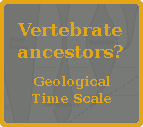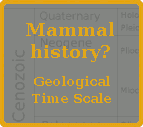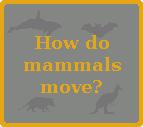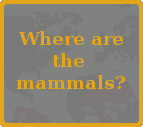Welcome to Mammal Diversity, the Burke Museum’s exploration of the diversity of Earth's mammals. Our tree diagram, down below, shows you the pathways of relatedness and historical evolution of today’s 29 different mammal orders. This phylogenetic tree also shows you that all of our modern mammals were derived from a common ancestor that lived over 200 million years ago. Click on each order for photos and a who’s–who of its members.

Mammals belong to the group of animals that have a backbone, or column of vertebrae. These vertebrate animals include various fishes, amphibians, reptiles, birds, and mammals. The vertebrates all descended from a common ancestor that lived over half a billion years ago. The Class Mammalia evolved later in the history of life on Earth, in the early Mesozoic, about 210 million years ago. Today we find mammals across all of Earth’s continental land masses, on the ground, in the ground, above the ground, and in the air, as well as throughout the oceans. Scientists recognize more than 5,400 species of mammals world–wide.

What distinguishes mammals from other vertebrates? Mammals have hair on their bodies for insulation and protection. Most of them have quite a bit of hair, but some, like whales, armadillos, and humans don’t have so much. Mammal mothers provide their newborn with milk from their mammary glands. Three special tiny bones (the hammer, anvil, and stirrup) that conduct sound through the middle ear of mammals to the hearing nerve in the inner ear also represent unique mammalian characteristics. Mammals also have a single lower jaw bone (the dentary) on each side of their jaw. In fossil mammals, we can’t find hair or milk, but we can identify these special bones that are only found in the mammalian skull.
Click on the diagram to learn about each order.
- Monotremata
- Didelphimorphia
- Paucituberculata
- Microbiotheria
- Diprotodontia
- Peramelemorphia
- Dasyuromorphia
- Notoryctemorphia
- Afrosoricida
- Macroscelidea
- Tubulidentata
- Proboscidea
- Hyracoidea
- Sirenia
- Cingulata
- Pilosa
- Dermoptera
- Scandentia
- Primates
- Lagomorpha
- Rodentia
- Soricomorpha
- Erinaceomorpha
- Carnivora
- Pholidota
- Perissodactyla
- Artiodactyla
- Cetacea
- Chiroptera

The branching diagram above is a phylogenetic tree of modern mammals, showing how all modern mammals are related to one another. It is based on available scientific evidence for the evolutionary relationships among major living groups (orders) of mammals. The most recent common ancestor of all mammals lived about 210 million years ago, indicated by the black dot at the base of the tree. The earliest mammals descended from reptile ancestors. They were small, land–inhabiting creatures, not completely like the mammals alive today. Rocks from the Triassic (earliest) period of the Mesozoic era contain these fossil records. These earliest mammals laid eggs, just as reptiles do. Among today’s mammals only the platypus and the echidnas (Order Monotremata) lay eggs to produce their young; but, being mammals, they nourish their hatchlings with milk. Monotremes are the oldest of modern orders. Throughout the first 100 million years of their 210–million year history, mammals were basically small, generalized land–dwelling creatures. Compared to reptiles, mammals were few in number and probably many of them were active during the night. Among the earliest groups of modern mammals to evolve were the ancestors of today’s marsupials. These appeared in the fossil record during the later Mesozoic, in the Cretaceous, which is the time of the dinosaurs. Marsupials give birth to tiny, very immature young that are nourished with milk for a long developmental period; during the early stages of this development the young are continuously attached to their mother’s teats in a pouch (marsupium). Three orders of marsupial mammals (Didelphimorphia, Paucituberculata, Microbiotheria) live today in South and Central America (and marginally in North America). Four orders of the best known and most diverse marsupials are found in Australasia (Australia, New Guinea, and nearby islands). These are: Diprotodontia, Peramelemorphia, Dasyuromorphia, Notoryctemorphia. During the early evolutionary history of marsupials the present continents of Australia, Antarctica, and South America were joined, as part of the massive southern continent “Gondwana”.


The remaining 21 modern orders of mammals (often called the Eutherian mammals) branched off from one another relatively rapidly around 70 to 50 million years ago. This rapid diversification is recognized, in evolutionary terms, as an adaptive radiation. This means that mammals expanded the range of body forms and ways of making a living, or niches, by which species were able to survive. The resulting great variety of body forms, modes of locomotion, diets, skull forms, and dental anatomy that we see today mostly arose during this rapid radiation in the early Cenozoic, or early Paleogene. By the time of the Eocene and Oligocene epochs, mammals were represented by modes of locomotion that included not only walking, but running, crawling, hopping, climbing, gliding, and even flying and swimming. They came to occupy many ecological niches and every geographic corner of Earth. The whales and dolphins (Cetacea) represent one of the most dramatic of these evolutionary transformations. As descendants of the small, terrestrial, four–legged Mesozoic mammalian ancestors, whales developed new adaptations in the early Paleogene and took on a new body form, including loss of the hind limbs. With front limbs that evolved into flippers and with their fish–like body form, the Cetaceans became swimmers and divers. This evolutionary process allowed them to return successfully from the life of their mammal ancestors on land to the seas, inhabited by their much earlier ancient fish ancestors. Whales include the largest mammal species. Furthermore the largest animal of any kind, including dinosaurs, ever known to have lived on Earth, is the Blue Whale.


The adaptive radiation of modern mammals in the Cenozoic era resulted in the great variety of body forms and modes of locomotion that suit mammals for life in all of Earth’s major environmental media–land, water, and air. Depending on where it lives, an animal has different requirements for moving itself around (locomotion). The same general body plan and common set of bones in the skeletons of the early mammal ancestors have evolved into the diverse array of modern body forms. For example, the same bones of the arm or foreleg are modified into elongated running legs in hoofed mammals, into wings in bats, flippers in whales, and even “shovels” in moles. These and other evolutionary changes in mammals have all occurred since the time when the earliest common ancestors of today’s mammals derived the historic first characteristics that distinguished them from reptiles.


The diets, feeding behavior, and ecology of mammals have influenced the evolution of the shape of the skull and kinds of teeth in the jaws. Mammals use their teeth to seize and, in the case of some predators, to kill their food. Also, unlike many other kinds of animals, mammals use their jaws and teeth to break up and chew pieces of their food that are then further digested in the stomach. (Have you ever seen a bird, a reptile, or an amphibian chewing food?) Most mammals have a variety of different kinds of teeth in their jaws–incisors, canines, premolars, and molars. The numbers, shapes, and sizes of these different kinds of teeth, as well as the shape of the skull have become matched to deal with the feeding behavior and kind of food eaten by each species. Special extreme cases are also interesting. The tropical American anteaters have no teeth at all. An anteater just uses its tongue to slurp up ants and termites. Some of the biggest whales also have no teeth, but instead their mouths contain the brush–like filtering material called “baleen.” This material is used to pick up small shrimp–like “krill” that the so–called baleen whales filter from seawater. Mammals that are specialized for plant–eating (herbivory), whether they are small rodents or large elk, antelopes, or zebras, have flat, hard–ridged rear teeth (premolars and molars) that they use to grind grasses and other green browse plants. Specialized carnivores, such as members of the cat and dog families, have sharper, pointier rear teeth for piercing, tearing, and even shearing pieces of flesh. The longest and sharpest teeth in these carnivores are their canines. Other mammals such as humans, bears, and raccoons are omnivores and have more generalized rear teeth that are neither extremely flat nor extremely pointed; they are, instead, somewhat flat, but with rounded bumps or “cusps.” The incisors, in the front of the mouth, are the first teeth to grab and in some cases to cut the food. The long and pointed canines are piercing teeth, used mainly by predatory meat–eating mammals; in fact they are absent in most herbivores.
Most mammal females bear their young alive, but members of the order Monotremata (platypus and echidnas) lay eggs from which the young must hatch before they can be nourished by mother’s milk. Note that some other vertebrates, including some sharks, bony fishes, lizards, and snakes give birth to live young, rather than hatching eggs.


You have to travel around the world to see all the different kinds of mammals–kangaroos in Australia, giraffes in Africa, and mountain goats in North America. Why is this? The answer comes from knowing about Earth history. For example, the northern continents were joined together and the southern continents were joined together at the time of the early evolution of mammals, but then they became separated. This means that the new, smaller continents often maintained species that descended from common ancestors who originated on the big supercontinents. That’s how mammals now on different continents were able to share ancestry. At various times since then, connections have been reestablished between north and south. For example, North and South America were separated for a long time until they were reconnected at the “Panama Land Bridge” about 3 million years ago. These kinds of historic continental connections and reconnections explain the unevenness in the geographic diversity and evolutionary relatedness of mammals (and of course other organisms) across the globe. Although ancient Marsupials (a group of seven orders) have been recorded as fossils on most continents, their successes were greatest beginning at the time when South America, Antarctica, and Australia were connected; today we still find the greatest successes in Australia and South America–a heritage of the great late Cretaceous supercontinent of Gondwana. Over the entire Earth, scientists now recognize 29 different orders that make up the Class Mammalia. In Washington we have only nine of these orders, or just less than one–third of the world’s mammal biodiversity in terms of orders. In terms of species, the State of Washington has 141 species of mammals, which is just less than three percent of the 5400 mammal species found on Earth.
“Mammal Diversity” web design, graphics, images, and production by George Wang, May 2009.
Texts written by Jim Kenagy, Curator of Mammals
